
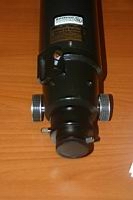
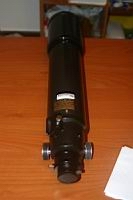



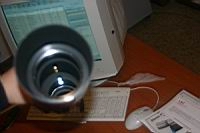
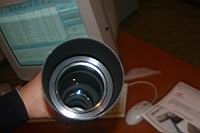
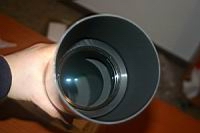


 RIFRATTORE
ORION 80 ED
RIFRATTORE
ORION 80 ED

|

|

|

|

|

|

|

|

|

|

|
| Specification | |
|---|---|
| Clear aperture: | 80.0mm (3.15") |
| Focal length: | 600 mm (23.6") |
| Resolution (visual): | 1.45 arc seconds |
| Resolution (photo): | 1.1 arc seconds |
| Coatings: | Magnesium Fluoride |
| Light Gathering Power: | about 123X that of unaided eye |
| Visual Magnitude Limit: | About 11.8 |
| Magnification range: | 11x to 165x |
| Tube assembly construction: | Painted finish, aluminum tube |
| Tube assembly length with 2/1.25 Reducer: | 19-1/2 Inches (49.5 cm) |
| OTA length with Dew Shield: | 23-1/2 Inches (59.7 cm) |
| Lens Shield Length: | Slip on, 5.25 Inches (133 mm) |
| Lens Shield OD: | 4.57 Inches (116.12 mm) |
| Front Cell OD: | 4.4 Inches (111.8 mm) |
| Lens Cover Diameter: | 4.573 Inches (116.15 mm) |
| Lens Cover Aperture Stop: | 2.07 Inches (52.5 mm) |
| Focuser type: | 2 inch Crayford |
| Focuser Travel: | 2.97 inches (75.4mm) |
| Weight of OTA: | 5.6 lbs. (2.6 kg) |
| 35mm prime-focus field: | 3.3 x 2.3 x 4 degrees @ f7.5 |
| 35mm field with Focal Reducer: | 4.1 x 2.8 x 5 degrees (vignetted) @ f5.5 |
| 35mm field with 2x Barlow: | 1.7 x 1.1 x 2 degrees @ f15 |
* Specifications are subject to change without notice.
Recensione di Fabio
Oggi in
ufficio sono solo ed ho un pò di tempo da perdere quindi ne approfitto
per riportare su questo bel forum un test completo su uno strumento di
cui molti parlano. Spesso le informazioni reperibili in rete sono frammentarie
e pubblicate solo dopo un breve utilizzo e non esaustive come dovrebbero
essere. Senza parlare poi delle riviste che pubblicano test ed a fianco
riportano la pubblicità del rivenditore dello strumento oggetto
di valutazione. Ci provo dunque io a parlare dello Skywatcher 80 ED dopo
alcuni mesi di utilizzo a 360°, senza peli sulla lingua.
Molti lo
definiscono apo, altri semiapo. Si tratta di un doppietto di cui un elemento
alla fluorite (made in Japan) ed un secondo in vetro crown. Tali vetri
vengono acquistati grezzi dal Giappone e successivamente lavorati presso
gli stabilimenti della Synta in Cina. La correzione è a mio avviso
superiore ai comuni semiapo ma non totalmente apocromatica. Sulle stelle
più luminose (es, Vega) in intra ed extra focale si nota un lieve
cambio di colore mentre a fuoco un esiguo alone azzurro attorno alla stella.
Ci tengo a specificare che si tratta di inezie e che sono andato davvero
a cercare il pelo nell'uovo. Parlerei quindi di uno strumento quasi-apo
se per apo intendiamo un tubo ottico COMPLETAMENTE privo di ogni tipo di
problema cromatico (ma ne esistono???).
INTUBAZIONE
ed ASPETTO ESTERNO
Il mio
modello è quello PRO, cioè quello di colore oro con anelli
bianchi. Chiariamo subito che l'unica differenza tra il modesso PRO e quello
blu consiste unicamente nel colore e nella dotazione. Infatti, il modello
S (blu) viene fornito senza anelli e barre, senza cercatore e senza oculari
ed anche ad un prezzo molto più basso. Lo consiglio nettamente rispetto
alla versione PRO in quanto la differenza di prezzo è a mio avviso
troppo sbilanciata.
Torniamo
al mio modello.
La colorazione
oro non è uniforme e presenta una differente densità in prossimità
del paraluce è comunque gradevole, nuova e di buon impatto visivo.
Il focheggiatore non presenta giochi, è preciso e molto fluido.
Forse un pò troppo lasco nei movimenti, problema parzialmente risolvibile
serrando con forza la vite che friziona lo scorrimento. Dopo questo piccolo
accorgimento, il focheggiatore riesce a tenere accessori di un certo peso,
diciamo anche fino a 0,5 Kg ma non sarebbe assolutamente in grado di sostenere
ad esempio una CCD Sbig.
Non si
raggiunge il fuoco senza l'utilizzo di un diagonale o di una piccola prolunga.
Il problema dell'inserimento di un diagonale non è marginale. Occorre
che questo accessoria sia di buona qualità e ben realizzato se non
si vogliono creare aberrazioni e distorsioni varie. Questo problema si
è purtroppo verificato nel mio caso. Utilizzando un (in teoria ottimo)
diagonale Vixen da 31,8 ho inizialmente notato un certo astigmatismo pensando
fosse un problema di collimazione dell'ottica dell'80ED. Successivamente
ho scoperto che si trattava del diagonale che introduceva distorsioni apprezzabili
e che non consentivano di ottenere stelle perfettamente puntiformi a fuoco.
Aggiungo
che la cella dell'obiettivo non è collimabile: sinceratevi prima
dell'acquisto che il rivenditore vi testi la collimazione. In caso vi ritroviate
tra le mani uno strumento un pò scollimato esistono in rete viari
siti dove si spiega come ovviare utilizzando piccoli distanziatori nella
zona di attacco del focheggiatore. Il mio esemplate è risultato
perfettamente collimato ed anche quello di un amico che ne ha acquistato
un altro assieme a me.
Voto globale:
8/10
LO STAR
TEST
Puntando
su una stella abbastanza luminosa ho effettuato questa analisi alla quale
non esistono alternative se si vuole capire il grado di lavorazione e correzione
di un'ottica. Ebbene, sia in intra che in extra-focale l'immagine stellare
è perfettamente uguale e non mostra apprezzabili difetti. Unica
piccola variazione è quella descritta sopra sulla lieve differenza
cromatica. Il livello qualitativo è alto e i risultati dello star
test sono inparagonabile a tutti quelli fatti sui newton che ho posseduto.
Nemmeno paragonabile a quello di un mio vecchio etx90 (ottimo) che però
mostrava in più una leggera aberrazione sferica e più simile
allo star test del mio MN61 Intes con ottica certificata ad 1/7 lambda
P.V. In base a questi paragoni, non credo di cadere in errore se affermo
che l'ottica ha una lavorazione non inferiore ad 1/5 lambda p.v. Dunque
ben oltre il limite di diffrazione collocato ad 1/4.
Voto globale
8/10
HI-RES
Ho avuto
modo di osservare Marte, Giove, Saturno, Luna ed alcune doppie.
Il massimo
ingrandimento utile lo colloco a circa 150x. Ricordiamoci che parliamo
sempre di un 80 mm e forzare troppo significa ritrovarsi con visioni troppo
scure per i miei gusti.
Su Marte
non si è mai faticato ad individuare i principali dettagli superficiali
ed anche la colorazione è sempre risultata naturale e gradevole.
Stessa
cosa dicasi per Saturno, nel quale la divisione di Cassini è sempre
ben evidente e la visione a livello di un ottimo 10 cm acromatico giapponese.
Buone visioni si hanno anche in serate dal seeing scarso grazie ai limitati
effetti su questa piccola ottica.
Su Giove
ho provato recentemente ma a 150x il disco era un pò troppo scuro
e non si notavano particolari dettagli oltre alle principali bande. La
serata era abbastanza velata ed il seeing mediocre ma mi aspettavo qualcosa
id più su questo soggetto.
La Luna
è sempre bella, con qualunque strumento. E' visibile sul bordo un
sottilissimo velo giallognolo. Ho potuto osservare visualmente dettagli
dell'ordine dei 3-4 Km in condizioni di seeing medie.
Sulle doppie
l'80 ED lavora molto bene, più di quanto faceva il mio vecchio Newton
Ziel da 20cm F/5. Molto facile la doppia della lira, già a medi
ingrandimenti perfettamente risolta nelle quattro componenti.
Voto globale:
7/10
DEEPSKY
80 mm sono
sempre pochi per gli oggetti del profondo cielo ed ovviamente non sono
il forte di questo piccolo rifrattore. Dalla città sono riuscito
ad intravedere le galassie più luminose del catalogo messier tipo
M81, M82, M65, M66, M51. Ovviamente la visione si è limitata alla
percezione di deboli fiocchetti lattiginosi e niente di più. Discorso
un pò diverso per gli ammassi aperti. Bello il doppio ammasso di
perseo e M103. Da notare l'ottima puntiformità delle stelle ed anche
le più luminose si riducono quasi a punte di spillo. Sulle nebulose
planetarie per notarle occorre ingrandire almeno fino ad 80-100x ed a questi
poteri, la visione è già un pò troppo scura.
Voto Globale
5/10.
FOTOGRAFIA
WEBCAM
Esiste
il grosso limite della corta focale e del piccolo diametro. Per riprendere
proficuamente Giove ad esempio, servirebbero almeno 5 metri di focale.
Valore irraggiungibile per l'80ED che al massimo può essere portato
a 2,5/3 metri su pianeti molto luminosi. Insomma, ci si deve accontentare
di piccoli dischetti. Al contrario, la correzione cromatica è tale
da mostrare il globo di giove bianco e le bande color mattone e non violacee
come accade nei rifrattori acromatici. Stesso discorso vale per Saturno
dove
gli anelli restano bianchi ed il disco rimane della sua colorazione originale.
Buoni lavori
si possono fare sulla Luna dove l'aspetto coreografico spesso sovrasta
la ricerca della massima risoluzione raggiungibile.
Ricordo
inoltre che sempre a casua dell'impossibilità di focheggiare senza
diagonale, potreste incontrare problemi facendo riprese con barlow a fuoco
diretto. Occorre preventivamente provare e verificare.
Voto Globale:
6/10
FOTO CCD
Questo
è il reale campo di battaglia dello SW in questione. E' infatti
abbastanza luminoso e le stelle restano piccoline se si focheggia alla
perfezione. Con la mia mx716 in serate di seeing buono, una stella a fuoco
prende solamente un pixel.
Inoltre,
la corta focale lo rende particolarmente appetibile per chi usa sensori
dalle ridotte dimensioni. Volendo rimanere attorno ai 2 arcsec. di risoluzione,
una Mx716 è molto indicata.
Nelle foto
LRGB, le stelle non mostrano alcuna dominante e l'aberrazione cromatica
è praticamente inesistente.
Il ridotto
ingombro ed il peso molto contenuto, consentono di usarlo fotograficamente
anche con montature economiche della classe EQ5/CG5/GP. Probabilmente il
modello 120ED darebbe risultati migliori in quanto i 4 cm in più
si farebbero ben sentire ma se guardo il prezzo di questo tubo cambio subito
idea.
Voto globale:
9/10
OSSERVAZIONI
TERRESTRI
L'80ED
è anche ottimo per spiare la bella dirimpettaia.
La vedrete
bella luminosa, senza distorsioni e senza colori spuri che nelle osservazioni
diurne sono classiche con strumenti acromatici. Ovviamente la destra e
la sinistra sono invertite. Andate a dare un occhio al costo di uno spotting
scope apo per osservazioni naturalistiche....
Voto globale
9/10
DA BUTTARE
L'impossibilità
di focheggiare senza diagonali mi rode davvero tanto. Probabilmente è
inevitabile in rifrattori così corti ma si tratta di una cosa che
ho appreso solo dopo l'acquisto e mi ha disturbato non poco.
DA TENERE
E' venduto
ad un prezzo ridicolo rispetto alle sue caratteristiche, se poi lo comprate
all'estero risparmiate anche un 150 Euro. Davvero un acquisto molto vantaggioso.
A CHI E'
ADATTO?
Non è
adatto per chi vuole osservale la divisione di Enke su Saturno ed i craterini
all'interno di Plato, sia visulmente che con riprese webcam. Non è
neppure adatto a chi vuole fare deepsky serio, a meno che non facciate
trasferte sotto cieli con magnitudine visuale +7.
E' invece
perfetto come secondo strumento trasportabile, per fotografia CCD e per
simpatiche osservazioni planetarie. Ottimo anche come primo strumento per
chi non vuole rinunciare alla qualità fin da subito, senza svenarsi
e ritrovandosi poi uno strumento che resta anche dopo il secondo acquisto.
Lo consiglierei anche a chi non ama attendere ore per acclimatare, collimare
per poi rendersi conto che il seeing non consente di fare osservazioni.
Molti considerano il modello più grande, il 100 ED ottimo e forse più adatto all'alta risoluzione ma non ho avuto modo di provarlo personalmente. Sono invece molto attratto dal grosso 120 ED il quale però sembrerebbe meno corretto dal punto di vista cromatico. A tal riguardo, nemmeno le riviste del settore sono riuscite a mio avviso a chiarire bene le idee. Non pubblicando il classico star test così come fatto per o due modelli più piccoli. Purtroppo però se anche il 100 ED si mantiene su un prezzo appetibile, il 120 è fuori mercato con i suoi 2600 Euro (solo ottica). Ok, si tratta di un semiapo da 12 cm ma allo stesso prezzo si potrebbero acquistare ottiche che renderebbero di più in tutte le condizioni di utilizzo. Alcuni definiscono il 120ED quasi apo, altri lo collocano a metà strada tra un acromatico ed un apocromatico. Insomma, ci sarebbe una bella differenza tra le due visioni.
In conclusione,
mi scuso se ho tralasciato dimenticando qualcosa e vi invito a far notare
eventuali incorrettezze nel testo.
Intes MK69
Skywatcher
80 ED PRO
EQ6 SkySkan
Pro
CCD MX716
& WebCam Vesta Philips
Home page
@: http://astrofabio.altervista.org/
Caratteristiche tecniche:
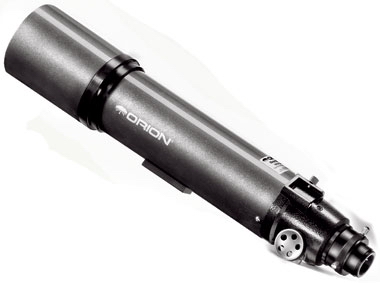
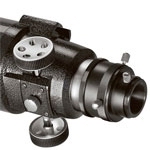
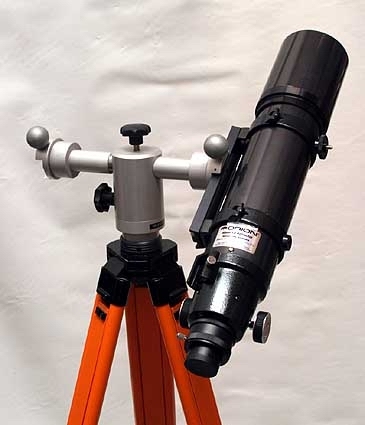
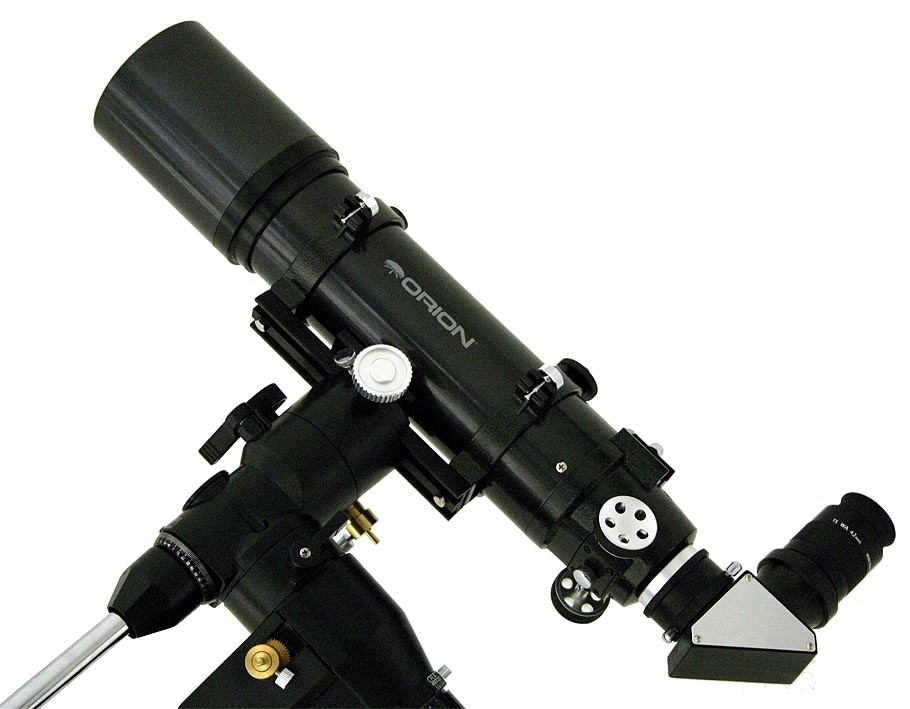
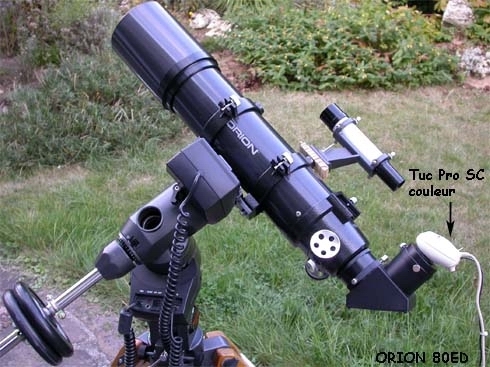

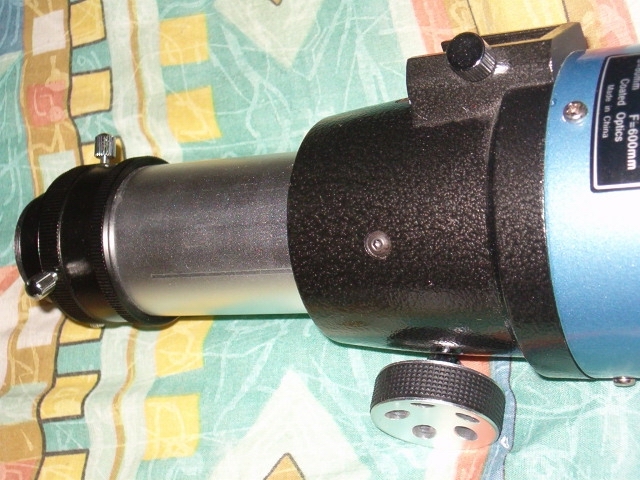
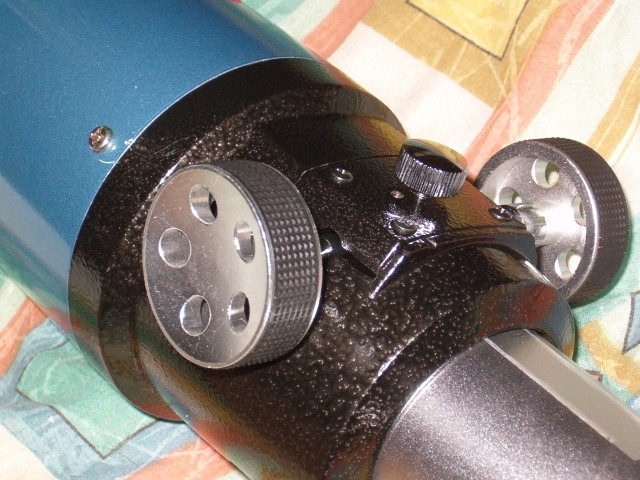
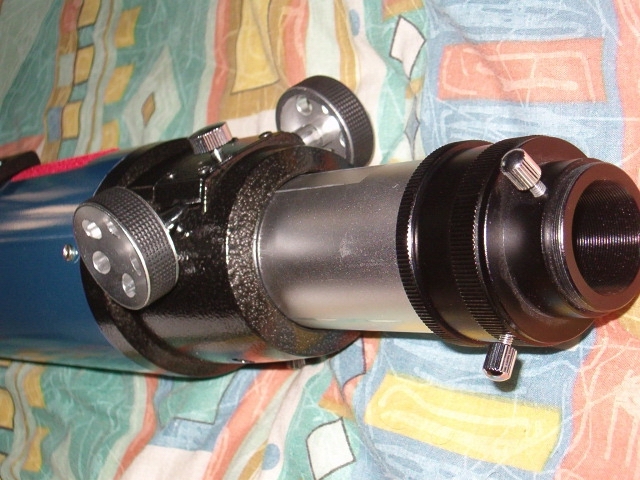
ORION 80mm
f/7.5 ED Apochromatic Refractor Versus Masked 80mm Televue 102 Apochromatic
Refractor
By Wing
Eng - 5/18/2004
I was “awakened”
recently, in the middle of the day, by an emailing from my good Oregonian
friend, Joseph Wong, whose message served the same purpose as that of a
highly effective, decibel-unlimited, alarm clock in making me aware of
a brand-new 80mm ED apochromatic refractor scope from Orion for the remarkable
price of only $429! After exploring the Orion Website, I excitedly noted
the following, paraphrased, information: The “ED 80” f/7.5 apochromatic
refractor is wonderfully suited to provide visual applications on both
solar system and deep-sky objects as well as for prime focus astrophotography
and CCD imaging. It contains a fully multicoated 80mm objective lens doublet,
one element being made from Extra-Low Disperson, or “ED” optical glass.
I honestly must confess I was seriously thinking of plunking down over $1300 for a Televue 76 mm apochromatic scope, when this new Orion 80mm ED presented me a low-cost-alternative opportunity. Hmmmm, could this scope be anywhere as nice in performance as the highly touted Televue 76?! After hearing that a few of the Orion ED 80’s would, that very day, be driven down from the Headquarters warehouse in Watsonville, CA, I decided that now was the time to take a drive down to Orion’s retail store in Cupertino, a bit south and west of San Jose, CA, to get a look-see at these new optical wonders….well at least as claimed by Orion.
By the way, I have no financial interest or gain in any products from Orion Telescopes and Binoculars.
Now back to the story. Orion’s Cupertino retail store has plenty of scopes, binoculars and accessories to both look at and to try out with several Orion-blue-smocked personnel ready to be of assistance to any interested customer. I asked if the new ED 80’s had arrived and was told, just wait a moment….and almost immediately one of these still-boxed-up apochromatic tube assemblies was brought out to me, from the rear store room, to examine. I spied a nearby Orion Standard Paragon tripod and asked one of the long-time Orion employees, Ken, if he could secure the new apochromatic scope, with its built-in ¼”-20 mounting plate onto it. “Well sure!” was the reply and in no time at all I got a chance to have a “first light” day-experience with the Orion ED 80 tube assembly, of 600 mm focal length, which was painted in gunmetal gray and came equipped with a 2 inch to 1.25” adapter. I took a careful look at the coatings on the primary 80mm ED objective lens and saw only greenish colored images of the store’s fluorescent lamps reflecting off the lens and absolutely no white colored reflections from the same lamp images; a testimony to the fact that the primary is fully multicoated. No other accessories or diagonal is supplied with this scope, so I “borrowed” one of the retail store’s right angle star diagonals, a 6X30 finder scope, and several eyepieces of various focal lengths.
In particular, I tried out an Orion Expanse 6mm eyepiece which yielded 100X and found the sun’s point-image as reflected by telephone pole insulators several hundred yards away to be really sharp as well as the sharp image of the wood making up the telephone pole, itself. I was quite impressed by the backlash-free 2” Crayford-style focuser, which operated very smoothly and which reminded me of the same looking focuser on the Televue 102, although I realize the focuser on the Televue is better built and even a bit smoother. The nice part of this focuser is that it has NO GREASE to get on your fingers/hands when operating the scope. More than intrigued by the nice “day time testing,” I paid for the Orion ED 80 scope, plus a 6X26 mm correct-image finder scope which easily fit into the molded-in dovetail base of the ED 80 Optical Tube Assembly(OTA), and eagerly headed about 43 miles north east to my home in San Ramon, CA.
The following are three separate sets of observations, made during three separate viewing sessions:
The first session was made while comparing my brand new Orion 80mm ED Apochromatic scope with my “Accidental - see previous Cloudynights article” scope, a Televue 102mm, costing over $2000, masked down to 80mm aperture. The Orion 80mm ED was outfitted with a 6mm Orion Expanse eyepiece(yielding 100X), while the masked Televue 102 was equipped with a 9mm Orion Expanse eyepiece(yielding 98X): The ED scope was secured to a Televue Upswing mount, while the Televue 102 was positioned on a Gibraltar mount. I used enhanced Lumicon right angle mirror diagonals labeled as 96% reflectivity for all three viewing sessions.
Date of Observations: Thursday, August 14, 2003, 11:30pm, with overhead limiting magnitude of about 4.0.
1.) 90% Illuminated moon. The Televue 102 performed better, although just barely, because the Orion ED 80 had just a minor, and very thin, amount of yellowing at the very edge of the bright limb, which I had to look for in order to see it. The Televue 102 had no perceptible bright limb color. Contrast wise, both scopes performed very admirably on the lunar surface, with no perceivable chromatic “violet haze” which allowed small lunar landmarks to be viewable through both scopes in an equally nice way. Advantage: Slight edge to the Televue 102
2.) Mars. Sporting a diameter of 24.4 arc seconds and glowing brilliantly with a magnitude of -2.4. Quite close to its historic August 27th, 2003, closest approach in over 1000 years when it will present a diameter of 25.1 arc seconds/at magnitude -2.9. Both scopes showed the Martian dark-green surface markings and both scopes also showed the polar ice cap clearly defined. There was absolutely no chromatic/violet glow surrounding the disk of Mars. Advantage: Call it a tie.
3.) Double Cluster in Perseus. On this lovely double-open cluster duo, I observed a tad better performance with the Orion ED scope, although the view in both scopes was very nice with crisp stellar images and with both scopes clearly displaying the red giant stars in the grouping. Advantage: Slight edge to the Orion ED 80.
4.) Epsilon Lyrae(Double-Double). Both scopes easily “split” this object. Advantage: Call it a tie.
5.) Vega(Alpha Lyrae). Both scopes showed a wonderfully classic apochromatic set of diffraction rings around this bright blue-white 1st magnitude star with no discernible chromatic violet aberration around the star. Advantage: Call it a tie.
6.) Star Test. It was interesting that the in-and-out of focus rings were a bit rounder in the Orion 80mm ED scope compared to the Televue 102mm scope. However, please don’t knock down the fine optics of the Televue 102 because I verified that the better “performance” by the Orion 80mm ED scope was due to the 80mm “mask” on the Televue 102 being cut out by me, unfortunately, a bit “out of round.” Advantage: Really a tie!
Eagerly impressed by this new Orion 80mm ED scope, I decided to try it out during my second viewing session, but only “solo-style,” using my Orion Expanse Series Eyepieces and an Orion Shorty 2X barlow as follows:
Date of Observations: Sunday, August 17, 2003, 5:30am, with overhead limiting magnitude of about 4.0.
1.) 73% Illuminated
moon. The Orion ED 80 clearly and crisply displayed the largest craterlet
within Plato, approximately 3km/2mi in diameter, at both 133X and 200X
using the Expanse 9mm and Expanse 6mm eyepiece with 2X Orion Shorty barlow,
respectively.
Again, no
chromatic violet aberration was viewed outside the moon’s bright limb.
2.) Saturn. This outer gas-giant planet showed off Cassini’s Division clearly around the ring system with one light tan belt evident at 200X, using a 6mm Expanse eyepiece and 2X Orion Shorty barlow.
Note(for both observations 1.) and 2.), immediately above): Orion states the highest theoretical magnification is 165X for the Orion ED 80mm apochromatic scope, but I believe that under steady atmospheric conditions, 200X or 64X per inch aperture is and was attainable.
3.) Orion Nebula. The Trapezium was viewed with its very lovely blue-gray nebulosity at 30X using a 20mm Expanse eyepiece.
The third and final viewing session was conducted using a set of Orion Highlight Series Plossls as follows:
Date of Observations: Wednesday, August 20, 2003, 10:30pm, with overhead limiting magnitude of about 3.5.
1.) Globular Cluster in Sagittarius. M22 was completely resolved, at 80X, by the Orion ED 80 using an Orion Highlight 7.5mm plossl eyepiece.
2.) Galaxies in Andromeda. M31’s oval-shaped outline was clearly seen though the Orion ED 80, while both of the 8th magnitude companion galaxies, M32 and M110, were visible with direct vision at 30X when using the Highlight 20mm plossl eyepiece. Note: Very nice light gathering ability for this ED 80; especially on the low surface brightness companion galaxy, M110, considering the overhead limiting magnitude was about 3.5.
3.) Double Star Gamma Andromedae. This one was very easy to split at 30X, when using the Highlight 20mm plossl eyepiece, as the Orion ED 80 showed a “clean” separation between the yellow primary and the blue companion of this picturesque double star.
Conclusions: The Orion 80mm ED Apochmatic Refractor is a true “bargain” in the world of apochromatic telescopes and, in my opinion, may not be easily equaled, both optically and mechanically, when considering the open-market of quality refractors. Sure, for many hundreds of dollars more, one can get a better apochromatic scope, but is it really worth the additional cost? At 5.7 pounds, it is a lightweight performing like a true heavyweight in the realm of highly recommended OTAs.
P.S. All 30
or so original-stock Orion 80mm ED Apos have been purchased and there is
about a 25 day minimum wait until a new shipment arrives into Watsonville,
CA, Headquarters.
